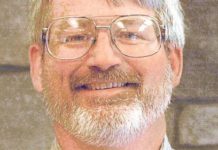Fall hatches are in full swing now on the lower Shoshone and the Wind-Bighorn rivers in the Big Horn Basin. These hatches generally begin sometime in mid-October and last until the end of December or early January before ending.
This is a great time to hook and land nice size trout using dry flies that, in this writer’s case, requires the use of magnifying glasses to tie onto the end of my leader tippet.
Blue-winged olives, also known as Baetis by fly fishers, are dominating the trout’s attention on both these tailwater fisheries right now. This tiny olive-colored mayfly with slate gray wings begins to get active sometime late morning and continue to emerge (hatch) right through mid-afternoon before the hatch subsides.
The best dry flies for me this past week have been size 16-20 olive or gray parachute Adams, sparkle duns with a copper-colored Antron tail, Compara-duns and standard dry fly blue wing olives.
Should the trout not be rising but just swirling on these insects, I switch to CDC emerger, RS2 and non-weighted, soft-hackled imitations of the same insect. Emergent imitations generally sit low in the water’s surface or hang just below the surface. These are easy pickings for the trout and these fly patterns often work better than those that float on top of the water because the angler’s tippet is less visible to a trout, so they are less picky when an emerger drifts down river.
Some anglers don’t like to use dry or emerger patterns but, instead, fish the nymph or larval stage of these insects. This is called nymph fishing and the angler has the choice of dropping these BWO non-adult imitations below a dry fly, called a dry/dropper rig, or they have the choice of dropping the nymphs below a strike indicator and use that as a signal for a strike, or take, by the trout. Others prefer to tight-line nymph fish and use no indicator, but either feel the take or see their leader tighten when drifting the nymphs below the surface.
All of these techniques work well. The choice is up to the individual angler. Great wet fly imitations are gold–rib hare’s ears in tan, olive or gray colors, pheasant tails, blue-wing olive nymphs and Copper Johns in sizes 16-20. Smaller flies, whether fishing on top, just below the surface or deeper requires tippet size to be 5X-7X. The use of lighter tippet size allows the angler’s imitation to drift naturally in the surface or river currents.
Heavier tippet sizes are more easily seen and also have the tendency to steer or drag the fly when presented, rather than letting the fly bob along as if it has no line attached. Catch rates increase on the lighter tippets, but there is an increased chance of breaking a good-sized trout off the line if the hook set is aggressive, or too much pressure (tension) is applied to the leader. Sometimes, it is better to use the reel’s drag than it is to strip the fish into the net because the trout can still fight hard. If the line is in your hand tightly, these runs generally end in a trout that has broken off and is now back in the water and much smarter for the experience.
The other hatch that is getting attention from the trout on the lower Shoshone is the fall caddis that seem to be active in the afternoon through early evening hours. Elk hair caddis are usually fished for the adult imitations. Size 12-16 fly imitations have been working well. The best color right now has been tan, brown and light-orange-bodied elk hair caddis. Below the surface, gray, tan or light orange soft-hackled flies work well, especially when swung through the water column as the leader tightens in the current and begins to move to the surface from water pressure (drag) on the fly.
Bead-head soft hackles add weight to get the fly down quickly or the angler can attach lead shot to the leader to accomplish the same effect, or fish a type 2 or 3 sinking tip fly line. If one does not have soft hackles, hare’s ear nymphs, tan North Fork Specials, Wade’s ATT emerger and LaFontaine caddis pupae also bring some great strikes when fished under an indicator, swung like a soft hackle, or dead drifted. Caddis activity seems to be heaviest where riffles turn into a deeper run or slick. These are great places to use caddis imitations.
Credit: Source link






























